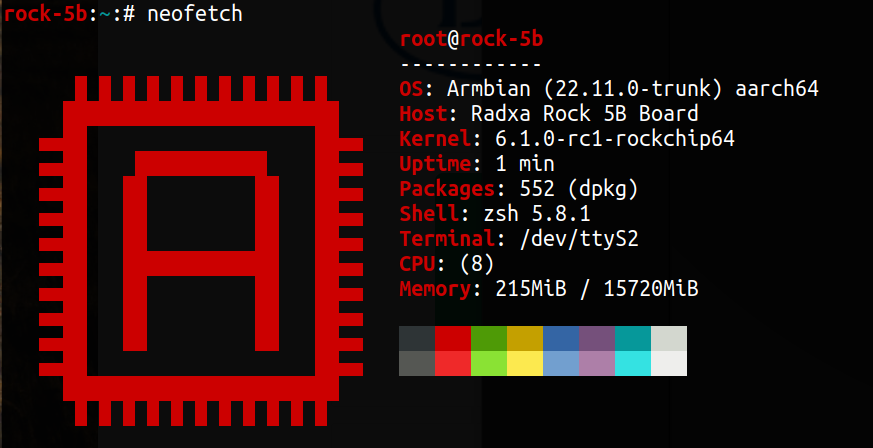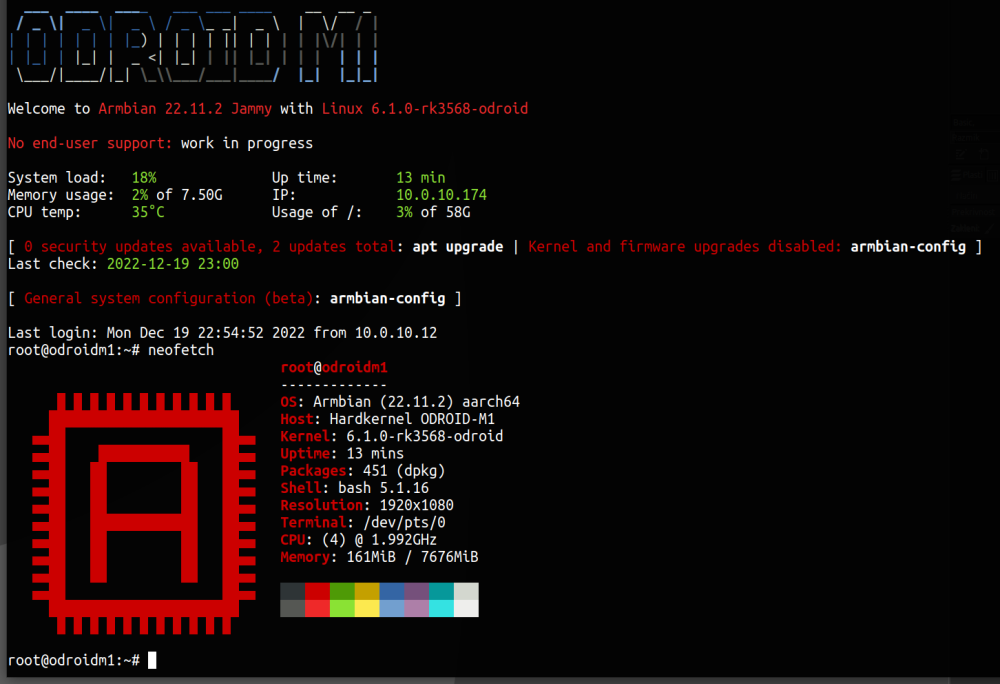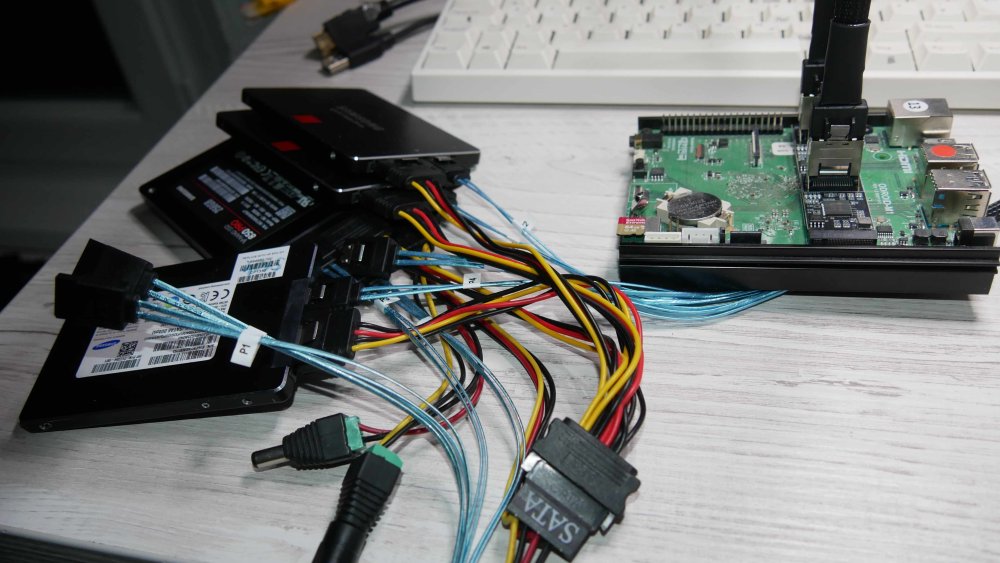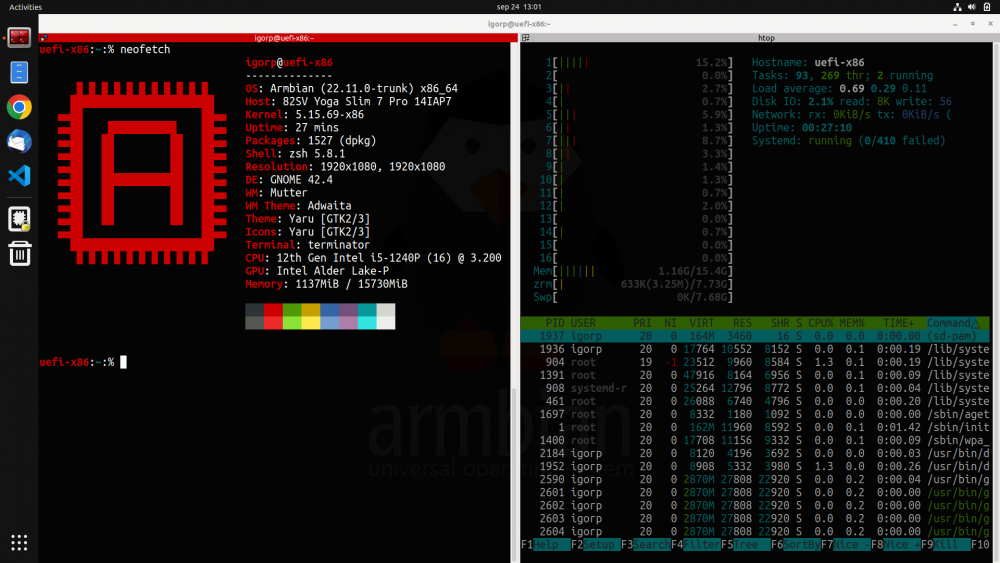-
Posts
14584 -
Joined
-
Last visited
Content Type
Forums
Store
Crowdfunding
Applications
Events
Raffles
Community Map
Everything posted by Igor
-
Video 1. Reviewing where we are with CI support 2. Challenges of upcoming release
-
This should fix it: https://github.com/armbian/build/pull/5132 Feel free to sent a PR in case you find something like that.
-
It looks like support is covered with this driver and there are not obvious reasons why it doesn't work. Try contacting people in the commit message. https://git.kernel.org/pub/scm/linux/kernel/git/stable/linux.git/commit/drivers/net/wireless/broadcom/brcm80211/brcmfmac?h=v6.3.1&id=0ec9eb90feec4933637fbde9d5bfbc3b62aea218 One is adding support and something else is keeping it in operational state once kernel changes. Sadly there is little we can assist here - wireless drivers are mess and we avoid them as one can eat us moths. And such luxury we don't have. P.S. Regarding your request. We have no idea why you don't have access to private forum - infrastructure bug Everything looks alright, but it doesn't work ... As we don't maintain this forum software on our own - its too complicated / not possible - we need to raise a ticket at 3rd party, which will take time and which is why I replied here.
-
You need to provide exact steps - what you did. Or better what you have ignored ... if you start with a destkop image, just follow 1st run wizzard and desktop will be loaded. If you skip one critical step (generating username) desktop won't run.
-
Possible quick fix is: sudo apt install armbian-firmware-full + reboot If that doesn't help, its more complicated.
-
This week meeting topics: 1. Upcoming release 2. Security in GitHub actions 3. CI support General goal of weekly meetings: To discuss the three (3) issues of the week Discussions will be documented to respective Jira tickets so they can be tracked Three (3) new issues will be selected from Jira for the next meeting The purpose of a weekly developers meeting is to coordinate development of the build engine, continuous integration, operating system features and low level support. Meetings are hosted located on Zoom (Video) and IRC and Discord (Text). While we would prefer you attend on Zoom when possibly, we will also monitor text chat during the call for those unable to join Zoom. Please RSVP either way. Do you want to participate or help in some way? Meetings are focused in developers top level topics and its expected that understand embedded software development, software testings or operating system management. In term of programming languages, knowledge of at least BASH & Python is expected. Since meetings are held in public, any registered community member can join and listen. If you want to suggest issues for the next week, you have to be recognized Armbian contributor. If you want to become one, resolve at least one intermediate level issue and tell us something about you. This is needed to efficiently communicate and to give you access to our organisation infrastructure Jira, Github, hardware lab and servers. @Contributor/Maintainer
-
If you will be digging in: - u-boot package contains information how to flash boot loader to eMMC/SD/SPI - this is install script that is called from armbian-config, also works as standalone armbian-install
-
https://docs.armbian.com/User-Guide_FAQ/#why-does-hardware-feature-xy-work-in-old-kernel-but-not-in-more-recent-one In some cases (Rock 5, Bananapi 5, ...) we are providing images with pretty well working but outdated kernel which is responsible for interacting with hardware. Difference between legacy and modern mainline is extreme. 1) devices that are plugged to the board were never officially supported. Porting drivers to the mainline for all Linux community (by a few people) is done in best effort manner. 2) it always works this way https://docs.armbian.com/User-Guide_Getting-Started/#how-to-install-to-emmc-nand-sata-nvme-usb unless it doesn't / its broken. If its broken it can be broken for all boards. SPI boot method is not always working / supported. My 2c
-
"Ubuntu" does not define interacting with the hardware, kernel does. As we don't use proprietary kernel from Hardkernel, this is done different, possibly its undeveloped feature. What you need to do is edit device tree and enable this UART (this is standard procedure on all boards). If overlays were made, then this is a lot easier: armbian-config -> hardware -> enable / disable, save, reboot.
-
Daily ATM and if it performs well, it stays that way.
-
https://docs.armbian.com/User-Guide_FAQ/#why-does-hardware-feature-xy-work-in-old-kernel-but-not-in-more-recent-one
-
Video 1. Progress of CI support - build matrix almost work. It could be integrated into production code, but we will do another week of polishing. - we have added on-demand cloud runners action to add additional 128 build runners when needed 2. Security concerns We talked about potential issues and how to improve that. A dedicated person, a CSO volunteer for Armbian project is most welcomed. There are issues in general and GitHub CI specifics, so understanding of those process is needed to understand or learn. @Contributor/Maintainer
-
Unknown. Plus I managed to fry the board. It was sent to repair, got repaired, it is coming back ... but sadly anyway don't have time to do anything. When they boots, images would be at the download pages with at least WIP / community support status. This might be helpful. https://github.com/Kwiboo/arm-trusted-firmware
-
Thanks to @Efe Çetin Lets keep it in WIP section for awhile until we don't do more testings. I found out armbian-install doesn't work well so this needs to be fixes, perhaps something else ...
-
-
Those are images versions IMAGE_VERSION= ... Probably is just adding confusion while otherwise it should not play a role if I understand this correctly.
-
This week meeting topics: 1. Progress of CI support 2. Security in GitHub actions 3. General goal of weekly meetings: To discuss the three (3) issues of the week Discussions will be documented to respective Jira tickets so they can be tracked Three (3) new issues will be selected from Jira for the next meeting The purpose of a weekly developers meeting is to coordinate development of the build engine, continuous integration, operating system features and low level support. Meetings are hosted located on Zoom (Video) and IRC and Discord (Text). While we would prefer you attend on Zoom when possibly, we will also monitor text chat during the call for those unable to join Zoom. Please RSVP either way. Do you want to participate or help in some way? Meetings are focused in developers top level topics and its expected that understand embedded software development, software testings or operating system management. In term of programming languages, knowledge of at least BASH & Python is expected. Since meetings are held in public, any registered community member can join and listen. If you want to suggest issues for the next week, you have to be recognized Armbian contributor. If you want to become one, resolve at least one intermediate level issue and tell us something about you. This is needed to efficiently communicate and to give you access to our organisation infrastructure Jira, Github, hardware lab and servers. @Contributor/Maintainer
-
Video 1. Progress of CI support https://github.com/armbian/os Changes: - release numbering changed from 23.05 -> 23.5 - we have two separate version configs. One for nightly, one for stable, so its easy to generate a new release. Full or partial - for a single board only. It automatically increment patch number when doing that. - all images are rebuild every run / night on 8 build clusters. - splitting testing related tasks from armbian/os to armbian/ci is planned for future - all currently enabled 3rd party packages are syncing also to stable repository. All those scripts needs to be feed with JSON which is still around a week or two before integration. We checked the progress. 2. Mechanism for rebuilding packages from sources We concluded its better to switch to some existing solution. As this is still a low priority and not needed for upcoming release, main development won't be touching with it within next two months. @Contributor/Maintainer
-
Those are developers preview builds, where you can check what works and at some point it will be good enough for some uses cases. In a couple of years, it will be functional on the level of kernel 5.10.y. Download is possible from CI pipeline: https://github.com/armbian/build/releases Boot log: This board is looking for maintainer(s) and (this) forum moderator (contact @Werner).
-
-
-
Just a reminder, if someone wants to fix it.
-
https://www.armbian.com/rock-5b/
-
Many of us are using Armbian not just on ARM single board computers but also on servers (bare metal & virtual). We use our builds since we trust it more then Debian, Ubuntu, not to mention other distributions that are recklessly updating and one ends up as an OS tester and not OS user. Personally I use Armbian Jammy on Ryzen 9 workstation with great success. My primary use case is development / productivity. For the road I used to have 13" Dell notebook which recently suddenly died. It was out of warranty so I had to get something new. After some testings of various devices I settled with 12th Gen Intel i5-1240P powered Lenovo. Then I tried many general purpose distros to see how well they work and all had some (minor) troubles ... We are having UEFI images (common image) since some time, but UEFI nor desktops were fine tuned nor ready for such performance daily driver desktop usage. We were close, but not close enough to just run it. Past two weeks we have been lifting general UEFI support, fixed many bugs and what came out is "Armbian ultimate developers desktop build". - improved support in GRUB (armbian wallpaper) & HiDPI GRUB support - all preinstalled applications are normal apt packages - current 5.15.y kernel, Jammy userland (5.19.y has some strange issues) - snapd is not installed (user can install it) - HiDPI support (automated adjustments on big screen resolutions) - NVIDIA graphics acceleration with proprietary driver (x86 only) - Intel graphics acceleration also works out of the box - preinstalled Google Chrome (x86 only) - preinstalled Microsoft Visual Studio Code (x86 only) - ZFS 2.1.5 ready (apt install zfsutils-linux zfs-dkms) - face unlock works perfectly fine on this laptop - installation to SSD drive to dual boot with Windows 10/11 is supported Armbian classical way by transferring actual live image to the prepared partition via nand-sata-install. All you need to do is prepare spare space on your drive, Windows 10/11 or Linux, UEFI support (most if not all hardware for past 10 years has it). I have tweaked images (XFCE, Gnome, Cinnamon) a bit to my personal needs, but making changes is welcome. Nice to have: disk encryption within nand-sata-install, small bug fixing, additional DEs. Currently we have CLI, XFCE, Gnome and Cinnamon. Others are too buggy. https://www.armbian.com/uefi-x86/ https://www.armbian.com/uefi-arm64/ Please report where it works and how (well)!








